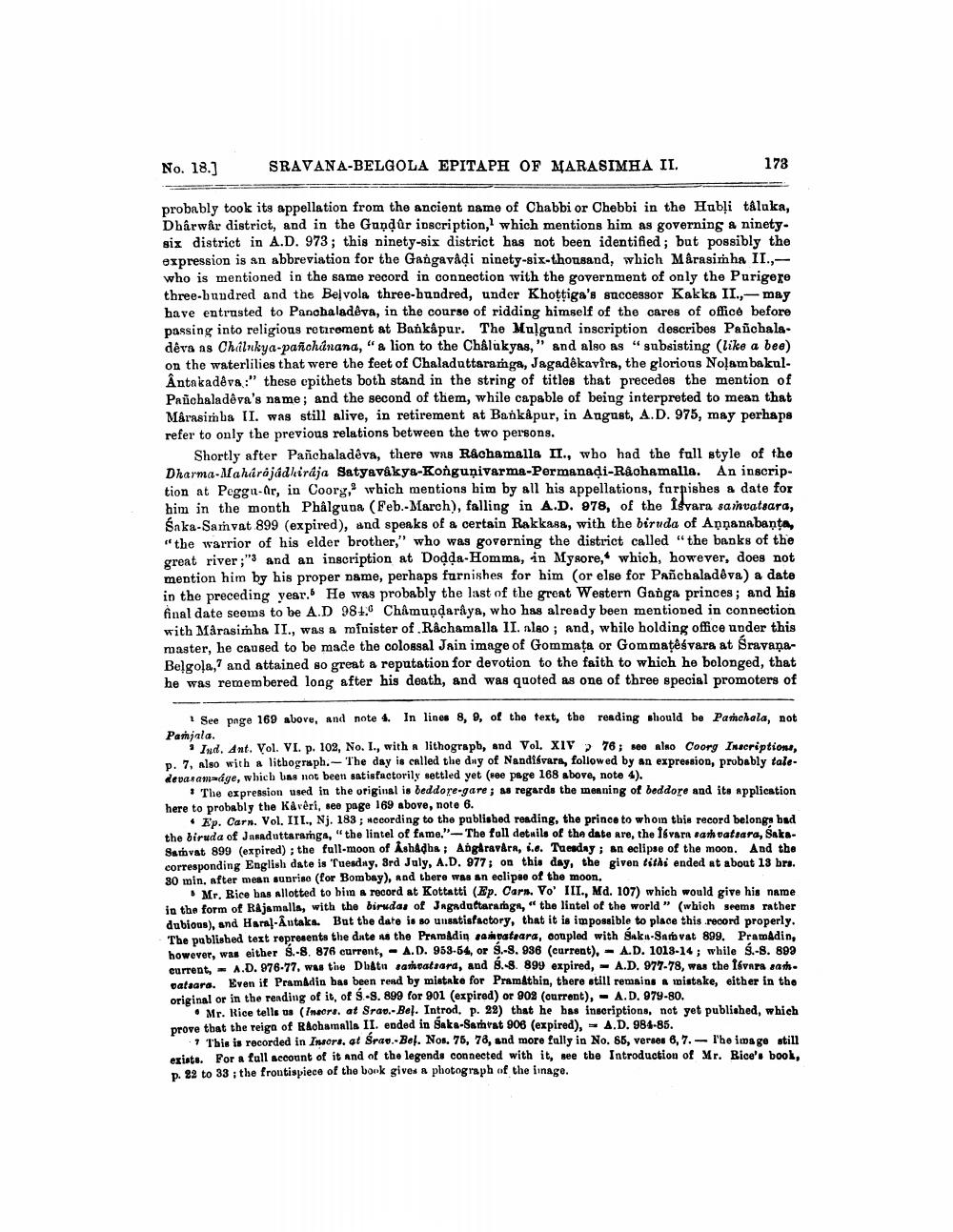________________
No. 18.]
SRAVANA-BELGOLA EPITAPH OF MARASIMHA II.
173
probably took its appellation from the ancient name of Chabbi or Chebbi in the Hubļi tálaka, Dharwar district, and in the Gundur inscription, which mentions him as governing a ninetysix district in A.D. 973; this ninety-six district has not been identified; but possibly the expression is an abbreviation for the Gangavadi ninety-six-thousand, which Marasimha II.,who is mentioned in the same record in connection with the government of only the Purigere three-bundred and the Bel vola three-bundred, under Khottiga's successor Kakka II.,-may have entrusted to Panobaladeva, in the course of ridding himself of the cares of office before passing into religious retirement at Bankapur. The Mulgund inscription describes Panchaladēvs as Chalnkya-panchanana, "a lion to the Chalukyas," and also as “subsisting (like a bee) on the waterlilies that were the feet of Chaladuttaramga, Jagadékavira, the glorious Nolam bakul. Ântakadêrs:" these epithets both stand in the string of titles that precedes the mention of Panchaladêva's name; and the second of them, while capable of being interpreted to mean that Márasimba II. was still alive, in retirement at Bankåpur, in Angust, A.D. 975, may perhaps refer to only the previous relations between the two persons.
Shortly after Panchaladêva, there was Rachamalla II., who had the full style of the Dharma-Maharajadhiraja Satyavákyl-Konguņivarma-Permanadi-Rachamalla. An inscription at Pegga-Or, in Coorg,' which mentions him by all his appellations, furnishes a date for him in the month Phâlguna (Feb.-March), falling in A.D. 978, of the Isvara samvatsara, Saka-Samvat 899 (expired), and speaks of a certain Rakkasa, with the biruda of Annanabanta, "the warrior of his elder brother," who was governing the district called "the banks of the great river;"3 and an inscription at Dodda-Homma, in Mysore, which, however, does not mention him by his proper name, perhaps furnishes for him (or else for Panchalad@va) a date in the preceding year. He was probably the last of the great Western Ganga princes; and his final date seems to be A.D 9840 Chamundaraya, who has already been mentioned in connection with Mårasimha II., was a minister of R&chamalla 11. also; and, whilo holding office under this master, he caused to be made the colossal Jain image of Gommata or Gommaţêsvara at SravanaBelgola, and attained so great a reputation for devotion to the faith to which he belonged, that he was remembered long after his death, and was quoted as one of three special promoters of
S
See page 169 above, and note 4. In lines 8, 9, of the text, the reading should be Paschala, not Panjala.
Ind. Ant. Vol. VI. p. 102, No. I., with a lithograpb, and Vol. XIV > 76 ; see aino Coorg Inscriptions, p. 7. Also with a lithograph. The day is called the day of Nandisvara, followed by an expression, probably taledevarandge, which bas not been satisfactorily settled yet (see page 168 above, note 4).
The expression used in the original is beddore-gare; ss regards the meaning of beddore and its application here to probably the Kaveri, seo page 169 above, note 6.
Ep. Carn. Vol. III., Nj. 183 ; According to the published reading, the prince to whom this record belonge bad the biruda of Jasaduttaramga, "the lintel of fame." - The full details of the date are, the 1svar tank satsara, Saka
yst 899 (expired); the full-moon of Ashadba ; Angravera, i.e. Tuesday; an eclipse of the moon. And the corresponding English date is Tuesday, 3rd July, A.D. 977; on this day, the given its ended at about 13 brs. 30 min, after mean sunrise (for Bombay), and there was an eclipse of the moon,
Mr. Rice has allotted to him a record at Kottatti (Ep. Carn. Vo' III., Md. 107) which would give his name in the form of Rajamalla, with the birudas of Jagadottarang," the lintel of the world" (which seems rather dubious), and Haral-Antaka. But the date is so unsatisfactory, that it is impossible to place this record properly. The published text represents the date as the Premidin rampateara, coupled with Baku-8th vat 899. Pramadin, however, was either 6.-8, 876 current, - A.D. 953-54, or 9.-8. 936 (current). - A.D. 1013-14 ; while s.-8. 899 current, A.D. 976.77, was the Dhatu rahatsord, and 8.-8. 899 expired, - A.D. 977-78, was the Isvara sanvatsara. Even it Pramadin bas been read by mistake for Pramåthin, there still remains a mistake, either in the original or in the rending of it, of 9.8. 899 for 901 (expired) or 909 (current), - A.D. 979-80.
Mr. Rice tells us ineors, at Srao.-Bel. Introd, p. 22) that he has inscriptions, not yet published, which prove that the reign of Riohamalla II. ended in Saka-Samrat 906 (expired), A.D. 984-85.
This is recorded in Incore, at Srao-Bel. Nos. 75, 78, and more fully in No. 65, verses 6,7. - l'he image still exists. For a full account of it and of the legends connected with it, see the Introduction of Mr. Bice's book, D. 29 to 33; the frontispiece of the book gives a photograph of the inage.




